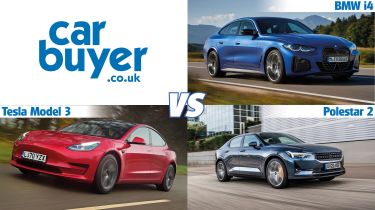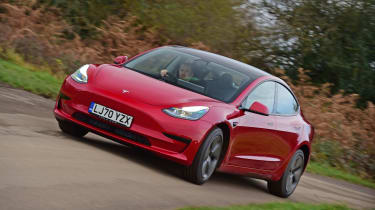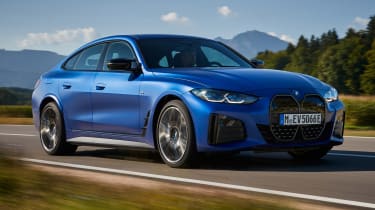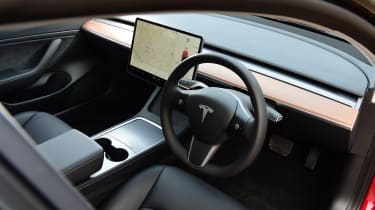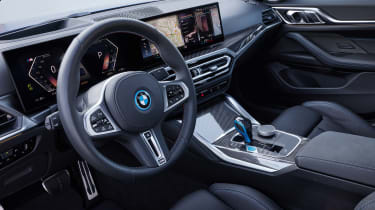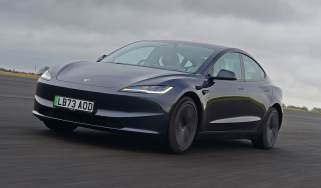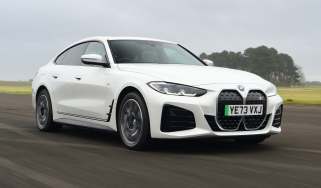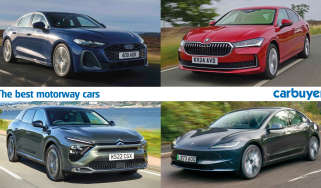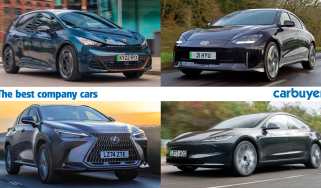BMW i4 vs Tesla Model 3 vs Polestar 2: which should you buy?
Which electric executive saloon is right for you? We compare the latest offerings from BMW, Tesla and Polestar to find out
When the Tesla Model 3 first arrived in the UK in 2019, it was a great pick if you were after an all-electric executive saloon-style car. With its strong performance, roomy interior and its ability to cover lots of ground on a single battery charge, the Tesla stood out on its launch as one of the best electric cars you could buy.
The Model 3 was also the best electric mid-size saloon car in 2019 by default, since at the time there were no direct rivals to the Tesla. However, things have changed quite a bit since then, because the Model 3 now has a pair of competitors: the BMW i4 and the Polestar 2.
Like the Tesla, the BMW and Polestar are all-electric executive cars with good ranges, useful practicality and plenty of in-car tech. So, does this mean the Tesla Model 3 has its work cut out to keep on top of its new nemeses, or does the Tesla still have enough in reserve to stay ahead of the pack? Read on for our full run down of the strengths and weaknesses of the three cars, and how they compare with one another.
Which has the longest range?
Unlike its rivals from Polestar and BMW, which use underpinnings adapted from the platforms used in combustion-powered cars, the Tesla Model 3 was designed from the outset as an electric car. As a result, it perhaps isn’t too big a surprise that the Tesla Model 3 can go farther than its competitors on a single charge. Tesla claims the Long Range version of the Model 3 can travel up to 374 miles before it needs to be plugged into a charging point, with this falling to 340 miles for the most powerful Performance version and 305 miles for the entry-level car.
While the Tesla does have the edge when it comes to range, it admittedly doesn’t have a crushing advantage. The BMW i4 in particular gets quite close to what the Tesla can manage; BMW quotes ranges of between 337 miles and 365 miles for the base eDrive40 models, with the exact range depending on the trim level and which optional extras are fitted, or between 258 and 318 miles for the sporty M50 flagship variant of the i4.
 Top 10 best used electric cars 2025
Top 10 best used electric cars 2025
In this company, the Polestar 2 doesn’t impress as much, although the car is still capable of covering lots of ground before the battery runs out of charge. Polestar claims the front-wheel-drive Long Range model can cover between 316 and 336 miles between charges, which falls to between 282 and 299 miles for all-wheel-drive Long Range cars, and from 272 miles to 294 miles for the entry-level front-wheel-drive standard spec. As with the BMW i4, the Polestar 2’s range varies depending on what equipment is fitted.
When it comes to charging speeds, the Tesla Model 3 again has a slim edge over its rivals. Depending on the version, a 10% to 80% charge takes between 21 and 34 minutes on the Model 3 using a 200kW charger, whereas its 31 minutes across the board for the BMW i4 using a 205kW charger and between 32 to 33 minutes with a 150kW charger on the Polestar. If you have a 7.4kW wall box at home, a full charge for the Tesla will take between eight hours and 12 hours 15 minutes, 13 hours for the BMW and between 10 hours 45 minutes and 12 hours for the Polestar.
Which is the best to drive?
If you’re a keen driver, you’ll probably be better suited with the BMW i4 than either the Tesla Model 3 or Polestar 2. While none of the cars here are bad to drive, the BMW feels the sportiest of the trio, thanks to its precise steering, planted body control and nicely balanced handling. Because the BMW i4 is a pretty heavy car, it isn’t as nimble as its combustion-powered BMW 4 Series Gran Coupe counterpart, although the fact much of the i4’s weight comes from the battery pack that’s installed low down in the car does help bring down the centre of gravity and somewhat mitigate those extra kilos.
In contrast, the Polestar 2 doesn’t feel as planted, although it’s still pretty stable and responsive so doesn’t feel out of its depth on a twisty road. You can sharpen things up even more on the all-wheel-drive models by opting for the sporty Ohlins adaptive suspension system – however, since it costs £5,000 and can only be adjusted manually when the car is stationary, it’s probably only worth going for if you’ll be driving the Polestar at track days on a regular basis.
 Top 10 best electric SUVs – the ones to buy in 2025
Top 10 best electric SUVs – the ones to buy in 2025
Of the three, the Tesla Model 3 isn’t as impressive when it comes to being a driver’s car. While nicely balanced and grippy in the corners, the Tesla feels a bit numb and flat in comparison with the more dynamic edge of the Polestar and BMW. You’ll still have a decent time in the Tesla, but those after behind-the-wheel thrills will want to look elsewhere.
Even though all three offer varying levels of fun, they’re more evenly matched when it comes to being comfy and refined cars to use every day. All three have comfortable ride qualities and good noise insulation, so are easy and relaxing to drive on long motorway jaunts. However, the Tesla Model 3 suffers from a bit more wind noise and tyre roar than the BMW and Polestar, and with the stiffer suspension fitted the Polestar 2 can feel quite firm at slower speeds and a bit choppy over rough roads.
Which is the most practical?
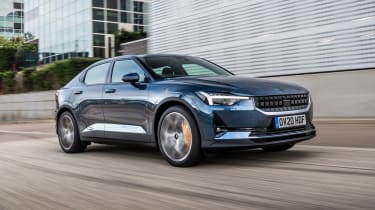
Because the Tesla Model 3 was designed from the outset to be an electric car, it benefits from not having to inherit the packaging compromises from a combustion-powered donor platform. Like most electric cars, the battery pack is stored underneath the floor, and since there aren’t any gearboxes or transmission tunnels to worry about, more space can be freed up in the interior. In the Model 3’s case, this results in a cabin that doesn’t feel that much smaller than the one in the larger Tesla Model S – although the sloping roofline does mean taller passengers don’t have a huge amount of headroom in the rear seats.
A similar story can be said for the equally rakish BMW i4, but the Polestar 2 claws back a few practicality brownie points with its smidge more rear seat headroom. However, both cars also inherit some legacy traits that betray the combustion-engined legacy of their respective underpinnings – for example, there’s a hump that runs through the middle of the BMW and Polestar, which eats into amount of foot space for your passengers (especially if all three seats in the rear row are being used).
 Top 10 best London Congestion Charge exempt cars 2025
Top 10 best London Congestion Charge exempt cars 2025
While all three EVs compete in a class that’s typified by four-door saloons, only the Tesla falls into this category: both the BMW i4 and Polestar 2 are technically hatchbacks, since their boot lids are hinged at the roof rather than underneath the rear window. While the opening itself is still a useful size, it’s easier to load larger and bulkier items into the boots of the BMW and Polestar in comparison, so bear that in mind if you’d prefer a big boot opening.
Since there’s no engine up front, you do at least get a front boot on the Tesla, which when combined with the Model 3’s back boot means there’s 425 litres of storage space in total. For reference, a Polestar 2 has a combined total of 445 litres (35 litres in the front boot; 405 litres in the back) and since there is no front storage area on the BMW, the i4’s cargo capacity is 470 litres.
Which comes with the best interior?
If you’re a fan of ultra-minimalist interior design, you’ll probably be won over by the Tesla Model 3. In this car, there are only a handful of physical controls, with much of the car’s functions being controlled through the gargantuan touchscreen set-up that takes up much of the centre console real estate.
It’s a pretty slick touchscreen, too, with prompt responses and little input lag. Plus, the screen’s sheer size and crisp display is of great use for when you’re using the touchscreen to show the sat-nav. However, it’s daunting that so many features can only be used via the touchscreen – there aren’t even any physical controls for opening the front boot.
In contrast, while both cars do still have a big touchscreen for most of the main functions, the Polestar 2 and BMW i4 do at least have a selection of physical controls, which makes them a bit more intuitive to use when driving – for example, you can tweak the climate control with buttons rather than through touchscreen menus. Also worth bearing in mind is that, unlike the Tesla, the Polestar 2 and BMW i4 come with Apple CarPlay and Android Auto support.
Overall, the cabins on all three cars look and feel nicely upmarket, although of the three the Tesla feels the weakest. That’s not to say the Model 3 is cheap inside – on the contrary, build quality is good and the materials are on par with what you’d expect from a car at this price point – but the BMW i4 and Polestar 2 have the edge when it comes to upmarket ambiance and premium plushness.
Which is the best value?
As the name implies, premium cars aren’t typically the most affordable cars out there, but buyers who want to save a few pennies when buying an upmarket electric car may want to consider the Polestar 2. With a starting price of just under £42,000 at the time of writing, it’s comfortably the least expensive car here, and at around £48,000 the priciest all-wheel-drive Long Range version is only a smidge pricier than the entry-level Tesla Model 3.
For the Model 3, prices currently start at around £46,000 for the most basic rear-wheel-drive cars, and top out at £60,000 for the range-topping Performance version. In this group, it’s the BMW i4 that’ll set you back the most like-for-like: prices range from roughly £53,500 for an i4 in the entry-level Sport spec and climb to £66,000 if the sporty M50 version takes your fancy.
Being premium cars, those prices can skyrocket even further depending on how many boxes you tick on the options list. For example, it’ll cost you £1,500 to replace the Tesla Model 3’s standard-fit 18-inch wheels with 19-inch ones, and if you’d prefer to have leather rather than cloth upholstery in your BMW i4, you’ll need to pay an extra £1,500.
The Polestar 2 in particular has some pretty pricey extras, since in many cases they’re only included as part of equipment packages. Cruise control, blind spot monitoring and a 360-degrees parking camera are bundled into a £2,150 pack, and the only way to fit a panoramic sunroof, power-adjustable front seats or rear privacy glass is to buy them all together as part of a £4,000 bundle.
With all of these cars sitting in the lowest band for company-car tax, your choice as a business user may come down to each car’s P11D value. As that follows the list price, the Polestar 2 could well be your preferred option.
Which should you buy?
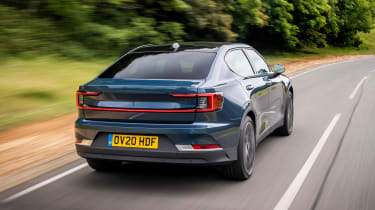
As we said at the start, the Tesla Model 3 impressed on its debut, and it still remains a great pick as an electric executive car. It’s an especially strong choice if you need something with the best possible range and slick in-car tech, and for some the appeal of using Tesla’s rapid charging Supercharger network could help tip the balance in favour of the Model 3.
However, the Tesla no longer has the de-facto monopoly in this class anymore, and these rivals have their own strengths. The Polestar 2 brings smart styling and good interior build quality to the table and is much more affordable to buy than the Tesla Model 3. The BMW i4 is among one of the most fun-to-drive electric cars on sale at the time of writing, and while it is more expensive than both the Tesla and Polestar you get a classier cabin, a bit more comfort and refinement, and more storage space (despite having no front boot to speak of).
As an all-round electric executive car, the BMW i4 makes a very convincing case for itself. However, the Tesla Model 3 and Polestar 2 are still worthy shouts if you’re in the market for such a car, so it’s definitely worth having a thorough look around all three if you can, to see which one of the three best fits what you’re after from your new premium electric car.
Check out our reviews of the BMW i4, Tesla Model 3, and Polestar 2
Recommended
Most Popular

New Smart #5 Brabus is a 637bhp far cry from the brand’s city car past

Best car leasing deals 2025: this week’s top PCH offers
Tips & advice

Car dashboard warning lights: what does each symbol mean?

Electric car charging stations: public networks, charger types, apps and maps

